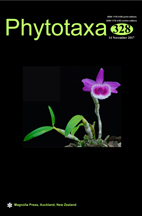Abstract
It is obvious that an illustration cited or provided in the protologue of a name can play vital role in typifying the name. In several cases it is observed that an illustration has been designated as lectotype. However, while selecting an illustration as lectotype it should be ensured that no cited isotype, syntype, isosyntype or paratype exists (which are to be given precedence), otherwise the lectotype designation will not be in conformity with Art. 9.12 of ICN (McNeill et al. 2012). If no cited specimens exist, the lectotype must be chosen from among the uncited specimens and then from the cited and uncited illustrations that comprise the remaining original material, if such exist. Clarke (1874) in the protologue of Championia multiflora Clarke (1874: 99) [currently accepted as Leptoboea multiflora (Clarke) Benth. ex Gamble (1881: 274)] cited “Hab. In collibus Khasia ad 500–5000 ped. alt. In Assam et Bhotan. In Sikkim ad 1000–5000 ped. alt. frequens”. Hence, the relevant specimens from the cited localities, i.e. Assam, Bhotan and Sikkim, studied by Clarke qualify as syntypes. Sinha & Datta (2016: 30) designated the plate (t. 68) given in the protologue as the lectotype of C. multiflora, but this is also contradictory to Art. 9.12 (also see Ex. 13 of Art. 9.19) of ICN (McNeill et al. 2012) because the cited syntypes should get priority over illustration given in the protologue during lectotype designation. We searched for these type specimens at CAL, K and P, and found that six of these specimens [CAL0000027254!; CAL0000027256!; CAL0000027257! P03552784 (image!); P03552790 (image!); P03552791 (image!); P03552792 (image!)] are present at CAL and P, which completely agree with the protologue.

